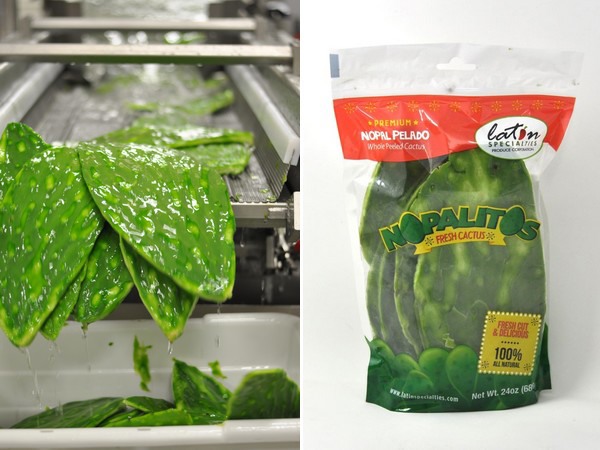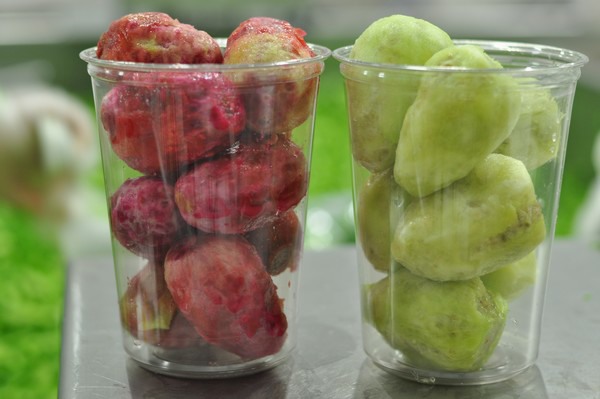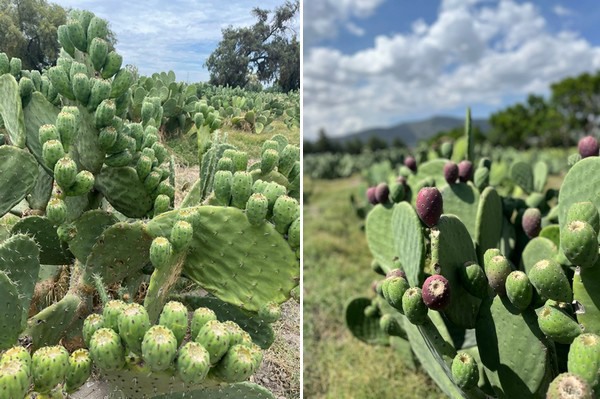“Cacti family of products is what we specialize in,” says Mayra Vazquez with Latin Specialties in Houston, Texas. Due to favorable weather, the cactus pear season has started early this year, though volumes are still low at the moment. The company specializes in the cacti family of products which include dragon fruit, aloe, cactus leaves, and cactus pear.
Latin Specialties’ Nopalitos and cactus pears are all grown in fields located on the outskirts of Mexico City. From there, the product is imported into the US and processed at the company’s processing plant in Houston, Texas. “We’re one of the largest processors of cactus leaves and cactus pears in the US, offering full food safety certifications all the way from the field,” Vazquez shared. At the facility, the product is pre-washed, peeled, washed, dried, diced, and bagged, following other food safety regulations. While cactus leaves are available year-round, cactus pears are available six months out of the year.
 Nopalitos washed and packaged.
Nopalitos washed and packaged.
Consumption has been showing a bit of a downward trend. “Both cactus leaves and cactus pears are very popular with 1st and 2nd generation Hispanics, but less popular with younger generations,” Vazquez said. The slimy texture of the product is what deters new customers from trying this very nutritious vegetable/edible plant. As for cactus pears, younger generations are not familiar with the art of peeling the fruit and how it is consumed. Latin Specialties offers fresh-cut options to make it easy for consumers to grab and enjoy this nutritious, exotic fruit. All processed products are natural and sold without additives.
 Peeled red and green cactus pears.
Peeled red and green cactus pears.
Exceptional nutritional value
In addition to the texture, education on nutritional value and utilization is key. “I am type 1 diabetic and have found both the cactus leaves and cactus pears to be very beneficial for my health,” Vazquez said. “The nutritional value is exceptional, and the sugar content in the fruit does not alter my glucose levels as much as other fruits do.”
Nopalitos are a staple during Lent as they serve as a meat replacement. “We have seen demand double or triple during Lent, but that’s the only peak in the year.” So far, cactus leaves are mainly being used in juicing and boiled or grilled, but Vazquez is hoping to expand consumption by finding other uses outside juicing and cooking. More recently, cactus pears have been catching on as an ingredient in drinks like beer and martini.
Shelf-life
Cactus leaves, and cactus pears are very sensitive to handling and temperature changes as these speed up oxidation, resulting in a product that looks less appealing. The product is fully processed on the same day of shipping to offer the customer the freshest product with the most shelf-life possible. With a shelf-life of eight to ten days, Latin Specialties chooses to limit the availability of its products to Texas and surrounding states.
Latin Specialties was established in 2000, and Nopalitos has been one of the company’s core items from the beginning. In addition to Mayra Vazquez, her brothers Sergio and Gorge are also involved in the family business.
 Cactus pears.
Cactus pears.
 For more information:
For more information:
Mayra Vazquez
Latin Specialties
Tel.: +1 713-986-3862
[email protected]
www.latinspecialties.com
